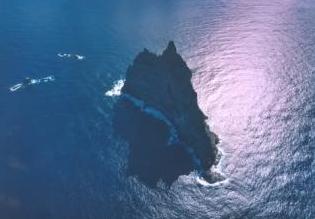Dryococelus australis
No live specimen of the Lord Howe Island Phasmid (Dryococelus australis) had been seen since the 1930s. It was thought that it may very well be extinct.The introduction of rats earlier in the century, had a tremendous impact on the wildlife of the isolated island, including the phasmid. The rarity and endangerment of its native species led to the island’s listing as a World Heritage Area in 1982.
In February of 2001, a group of five scientists travelled to one of the most spectacular islands in the world, Ball’s Pyramid, located 10 miles south west of Lord Howe Island in an effort to locate any surviving specimens. On two occasions in the past (the last in 1968), the body of a dead phasmid had been found on the island, so there was some hope the a vestigial colony remained.
Climbing in the middle of the night up a shear cliff face to a promising area of vegetation, the scientists discovered three live individuals, the first seen in almost 80 years. Efforts are now underway to bring the insect back from the brink of extinction, with the long-term goal of reintroducing it back to its original range.

Fig. 1. Ball’s Pyramid. Max. Elevation: 1,843ft (562m.)
Notes:
Ball’s Pyramid was first climbed on February 14, 1965 by Bryden Allen, John Davis, Jack Pettigrew and David Witham.
There is a short segment at NPR from October, 2002 that includes a mention of the phasmid here.


